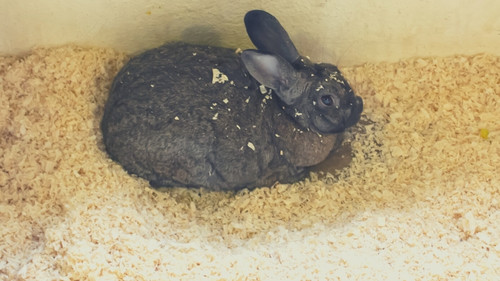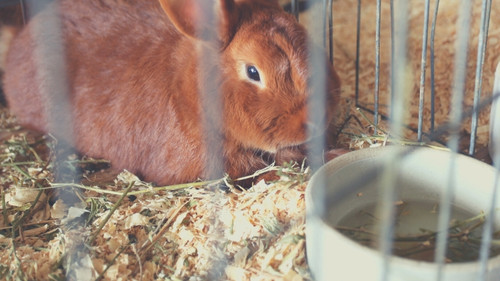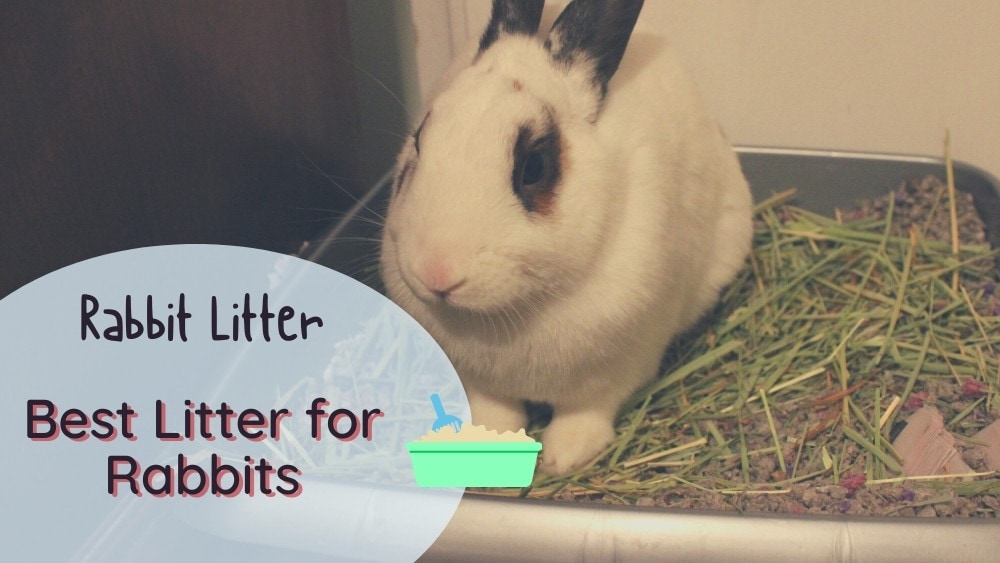Bunnies are winsome, affectionate, and among the cutest animals on the planet.
Also – let’s be honest – bunnies can stink.
Technically, your bunny itself doesn’t smell bad. (I think rabbit fur has a pleasant earthy smell.) It’s not even primarily your rabbit’s poop that stinks. But rabbit urine gives off ammonia and a nasty odor when left to sit for a few hours.
Using safe and odor-absorbing litter is key to keeping the bunny smell at a minimum in your home. Here are my favorite rabbit litter products available, and some pros and cons of each. (I currently have four house rabbits, so I need one that really works!)
What is the Best Litter for Indoor Bunnies?
The best litters for indoor rabbits are made of natural fibers like paper, wood, or straw that are ground and compressed into pellets. These litter pellets are low-dust, easy to scoop, and do a great job of soaking up bunny urine – which reduces the chances of odors building.
For my bunnies, I use Small Pet Select Recycled Paper rabbit litter. It’s affordable, lightweight, and – since it doesn’t contain baking soda like other brands – it’s completely dust-free and safe for rabbits to nibble. A 1” layer in my rabbits’ litter boxes absorbs urine so effectively that there’s little to no smell if I clean the boxes daily.
A Quick Comparison of Best Litter for Rabbits – 2023
Small Pet Select- Small Animal Pelleted Paper Bedding for Rabbits
- Natural Complete Odor Control
- 99% Dust Free
- Non Allergenic
- Extreme Absorbency
- 100% Made From Recycled Paper
- Suitable for In-floor bedding, drop trays, or litter boxes
Oxbow Animal Health Eco-Straw Litter
- All-natural wheat straw litter
- Clumpable and Scoopable
- Safe if consumed by pets
- Suitable for:Nesting boxes, litter boxes, drop trays
Small Pet Select - All Natural Pellet Bedding
- More absorbency per pellet
- Made from safe clean Pine, with no additives or irritants
- Free of the toxins associated with Wood stove pellets
- Recyclable and compostable
- Suitable for Litter boxes with mesh screens, slide-out trays under wire cage floors.
The Top 5 Best Rabbit Litter Products for Indoor Pet Bunnies
This is the same product as Small Pet Select’s recycled paper cat litter, just packaged and marketed for rabbit owners.
As a pelleted paper bedding, it is easy to handle and won’t shed dust when you scoop it. It’s lightweight, even when wet, and absorbs much more liquid than wood shavings of the same volume.
The downside to this product is that it doesn’t neutralize odors as well as wood or straw-based alternatives.
It doesn’t have its own fresh, natural fragrance like wood products do. But if soaks up so much bunny pee that, if you change the litter every day, urine puddles won’t collect in the litter box and won’t develop a strong smell.
This bedding is made of 100% recycled paper, unlike competitors like Carefresh which use new paper pulp. However, the Small Pet Select doesn’t clearly state whether the recycled paper is newspaper or not. Newspaper is usually printed with soy ink. While soy ink is technically edible and not a health concern for your rabbit, ink residue could be of concern for handlers with soy allergies.

- Sustainable: made from 100% recycled paper
- Light and easy to handle.
- Hypoallergenic: no wood oils.
- Zero dust; no added baking soda.
- Packaging is hard to handle. Pellets fall out when you open the box.
- Not as effective as wood or straw for neutralizing odors.
In years past, farmers used straw as standard bedding in rabbit cages. The problem with straw is that, while insulating, it isn’t very absorbent in its whole form.
Then Oxbow Eco-Straw Litter came on the scene. This unique rabbit litter is made of ground wheat straw compressed into pellets. In this form, it’s extremely absorbent – wicking twice as much moisture as paper pellets – and is also great at keeping the urine smell down.
Because it soaks up liquid so well, you can get away with cleaning the litter box less often if you use this straw-based bedding. However, it’s an organic material and prone to mold when wet, so you should still change it 2-3 times per week. It will begin to decompose and may even stain your litter box if you don’t clean it often enough.

- All-natural material that’s safe for rabbits to eat.
- Highly absorbent.
- Excellent at odor control and neutralization.
- More expensive than paper options.
- Forms sticky clumps that may mold quickly.
- May be of concern for those with wheat allergies.
- May be contaminated with small amounts of pesticides or herbicides.
These small, hard, easy-to-handle pellets are made of compressed pine sawdust.
We would never recommend fresh sawdust as bedding for rabbits (it’s known to cause lung cancer!) but these processed and heat-treated pellets are a safe option when used correctly.
They have little to no loose dust and are heat-treated to reduce pine oils that could cause liver stress or respiratory irritation in rabbits.
These compressed pellets work as well as aspen shavings at reducing odors. They do loosen and disintegrate when they get wet, so they can make a mess when you’re cleaning them up.
Although it’s relatively safe in this form, you still would not want to risk your rabbit eating sawdust. I recommend using these pellets only in places where rabbits can’t reach them, like in slide-out drop trays under wire cages, or in litter boxes that are covered by mesh screens.
The compressed pine pellets by Small Pet Select made our list of best rabbit litter because it’s one of the most affordable (while still effective) options you can buy online.

- Highly absorbent.
- Natural pine wood with no added fragrance or chemicals.
- Kiln-dried to reduce phenols and pathogens.
- Affordable yet effective option.
- Messy to clean up.
- Can mold if not changed regularly.
- Heavier than other options.
- Small but potential risk if ingested by bunnies.
Shredded hardwood Aspen is the safest wood-based litter or bedding for rabbits. I love using wood shavings in my rabbit trays because it has a pleasant natural masking fragrance – even if it technically doesn’t neutralize urine smell. As long as I change the litter every few days, my rabbit room smells faintly of fresh wood shavings when I use aspen.
That said, aspen wood isn’t too fragrant. It doesn’t contain the heavy-duty phenols found in softwood shavings like pine or cedar.
According to the House Rabbit Society, the compounds that cause strong fragrances in pine or cedar beddings can cause liver damage in rabbits.
Experts say hardwood shavings are less likely to splinter in a rabbit’s mouth than softwood shavings, which is another reason to opt for Aspen over pine.
Used as a litter, aspen shavings are moderately absorbent. They do the job, but they don’t suck up as much liquid as the pelleted litters on this list. They are too fluffy and large to work well in litter boxes, but they work well in cages with solid plastic or wood floors.

- No harmful phenols like softwood shavings.
- Light bright wood smell.
- Safe if rabbits chew on them.
- Doubles as a good rabbit bedding.
- Kiln-dried and heat treated to kill mites and pathogens.
- The size and shape of these shavings don’t work as well in covered litter boxes.
- Can’t hold as much moisture for its volume as pellet litter.
Carefresh is one of the safest and most versatile rabbit litters available. Fluffy, soft, and non-toxic, it’s completely safe for rabbits to sleep in, shred, and pee on.
If you’re looking for a solution that can be both litter and bedding for your bunny, Carefresh is our go-to.

- Completely hypoallergenic. No dust, no wheat, no added fragrances.
- No risk of splinters (like wood shavings); rabbits love to play with it.
- Lightweight and highly absorbent
- Since rabbits love shredding paper, using Carefresh could encourage bunnies to dig in their litter boxes.
- May not absorb quite as much liquid as compressed pellet litter.
- Although the package says it controls odors for 10 days, it’s wise to change the litter much more often than that.
What is Rabbit Litter and Is it Different from Bedding?
People often use the terms “rabbit litter” and “rabbit bedding” interchangeably. This comes from the practice of keeping rabbits full-time in solid-bottomed cages. Owners fill the cages with shavings or shredded paper, and since rabbits simply pick a corner to be their bathroom, the shavings function as both litter and bedding.

This idea is outdated for many modern pet rabbit owners. The luckiest house rabbits these days range freely or live in exercise pens rather than cages, and use a litter box rather than go pee in their own beds! Even rabbits that live in wire-floored cages now usually have a nesting box as a bed and a drop tray filled with litter for their poop.
So in this article, we used the term “bedding” to mean a nesting material used for warmth and comfort, and “litter” to mean absorbent material used to soak up bunny pee.
What Material is Best for Rabbit Litter? (Buyer’s Guide)
Products sold as rabbit litter are made from a range of natural materials including hardwood and softwood shavings, sawdust, paper, corn cob, straw, and even clay.
Paper-based beddings make the best rabbit litter because they are perfectly safe for bunnies and handlers. Wood-based litters are safe if used properly, while clay litters are highly dangerous for rabbits.
Features of Safe and Effective Rabbit Litter
Good rabbit litter must:
Absorb Urine
I’m always surprised at how much my rabbits pee. A large rabbit produces up to 650 ml of urine (22 ounces!) of urine per day, according to Bishops Stortford Vet Hospital. This means a few layers of newspaper in the rabbit litter box isn’t going to cut it.
Control Odor and Ammonia
Rabbit poop is dry and doesn’t smell very much. Rabbit pee is another story.
Ammonia is a pungent gas that’s created when bacteria interact with the protein in urine. The longer rabbit urine sits in liquid form and is exposed to air, the more ammonia it will release. While a strong ammonia smell can indicate dietary imbalances, all rabbit urine will produce some ammonia without a high-quality litter to keep it from puddling.
Be Perfectly Safe to Ingest
As every rabbit owner knows, bunnies explore the world by chewing on it. So if the litter is within reach, your bunny will try to eat it at least once.
It’s unlikely that your rabbit will consume large quantities of paper or wood bedding, but it’s crucial to choose a litter that won’t cause intestinal blockage in any amount.
What is the Most Absorbent Rabbit Litter?
The most absorbent litters that are safe for rabbits are compressed pellet beddings made of organic materials like straw, paper, or wood.
What Kind of Litter Prevents Rabbit Odors?
The smell of liquid rabbit pee builds up over time, so any litter that effectively absorbs moisture will also reduce ammonia production and prevent your home from smelling like rabbit urine.
In my opinion, the Oxbow Compressed Straw Pellet Litter is the most effective product at absorbing urine and preventing rabbit odors.
Many paper litters contain baking soda to neutralize the smell. This works well – some rabbit owners even sprinkle extra baking soda on the litter – but baking soda can irritate a rabbit’s lungs. So, rather than use litter with added baking soda, keep smells to a minimum by cleaning your bunny’s litter box every day.
Pro tip: You can also reduce odors and prevent ammonia production by spraying beneficial bacteria into your rabbit litter box.
3 Bad or Unsafe Litter Products for Rabbits
Three types of litter to AVOID using for rabbits are corn cob litter, clay-based litter, and plastic puppy pads.
Shockingly, manufacturers market these products for rabbits, but they are not safe.
Can You Use Cat Litter for Rabbits?
No. Clay-based cat litter is not safe for rabbits.
Most cat litter products are made of bentonite clay, which will clump when wet. If a rabbit eats bentonite clay, it could cause any number of reactions, but the clumping action itself can cause fatal blockages of the digestive system.
Since cats don’t eat their litter, manufacturers may put dyes, fragrances, or synthetic odor-reducing chemicals in them that are very dangerous for bunnies to ingest.
Watch out for products that are marketed for “small pets” like ferrets – and may include a picture of a rabbit on the packaging – but are made of clay.
Corn cob bedding won’t clump like clay, but it doesn’t break down and can similarly clog a rabbit’s digestive tract.
Can You Use Puppy Pads in Rabbit Cages?
Plastic-lined puppy pads are not safe to use in rabbit habitats. Rabbits will inevitably shred them and can ingest dangerous amounts of plastic, which a bunny’s system cannot break down or eliminate.
Washable puppy pads made of cotton are safe to use in a rabbit’s habitat.
How Much Litter Should You Use in a Rabbit Cage or Litter Box?
You should fill your rabbit’s litter box or solid-bottomed cage with 1-2” of pelleted litter. This will be plenty to absorb a rabbit’s pee for a day. Using deep layers of litter will tempt you to not clean as often, risking moldy bedding or bacteria buildup.

Conclusion
As you can see, choosing the right litter can have a huge impact on your pet rabbit’s health. Clumping or indigestible litter made from clay or corn can lead to life-threatening GI stasis if ingested. Cheap litter that does a poor job of soaking up urine can create ammonia buildup and respiratory stress.
That’s why we recommend a pelleted paper litter like the Small Pet Select Recycled Paper bedding as the safest choice for your bunny.
Small Pet Select Recycled Paper Pellet Litter
- Natural Complete Odor Control
- 99% Dust Free
- Non Allergenic
- Extreme Absorbency
- 100% Made From Recycled Paper.
- Material: Recycled paper pellet
- Package Size: 10lb or 20lb
- Suitable for: In-floor bedding, drop trays, or litter boxes
- Sustainable: made from 100% recycled paper
- Light and easy to handle.
- Hypoallergenic: no wood oils.
- Zero dust; no added baking soda.
- Packaging is hard to handle. Pellets fall out when you open the box.
- Not as effective as wood or straw for neutralizing odors.







